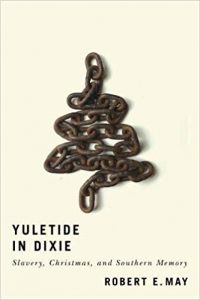Book Review: “Yuletide in Dixie: Slavery, Christmas, and Southern Memory”
 “Slavery, slavery, slavery! All this talk about slavery is spoiling the Old South Plantation Christmas celebrations!” Or so might Miss Scarlett complain. Robert E. May’s latest book, Yuletide in Dixie, is focused clearly on the irony of two competing mythologies concerning the celebration of December 25th in the southern states.
“Slavery, slavery, slavery! All this talk about slavery is spoiling the Old South Plantation Christmas celebrations!” Or so might Miss Scarlett complain. Robert E. May’s latest book, Yuletide in Dixie, is focused clearly on the irony of two competing mythologies concerning the celebration of December 25th in the southern states.
There are many accounts of the conventional Southern Christmas–a “Christmas in the Big House, Christmas in the Quarters” version that is as evilly two-sided as Santa’s diabetes-inducing cookies. Traditionally, December holidays gave slaves a relatively long and happy break from enforced labor and punishment, rewarding them with copious amounts of food, alcohol, and gifts. Enslaved people were allowed access to the main plantation house, informal verbal sparring with their owners, and visions of sugarplums galore danced through everyone’s head. The author quotes from diaries, letters both antebellum and during the war, and slave narratives from the 1930s expressing a wish to return to simpler times. Then May asks the question: is this true, or is the reality far more complex and troubling?
This book is compelling, disturbing, and not a little frustrating. May, Professor Emeritus of History at Purdue University, asks his readers if the former accounts of southern yuletide might not simplify the perspectives of the enslaved themselves. The literary tropes concerning southern Christmas traditions have at least two sides if examined differently. Just as many letters and diary entries, as well as newspaper accounts, present evidence that white southerners dreaded Christmas. There was widespread fear of slave revolts, slaves not returning from Christmas excursions to places other than the home place, and violence from inebriated slaves being a real possibility. Notations made in plantation journals and daybooks indicate that whippings did indeed occur during the holidays. Even worse, bills of sale show that families of enslaved people were often split apart and sold off during this time as well.
Taken at face value, prior assumptions about antebellum Christmas in the South may seem to be the stuff from which fairytales are made: delicious hams, mince pies, oranges, gifts from fancy stores in the North and Europe, and cheerful music from the quarters accompanying the annual game of “Cris’mus Gif.'” Unfortunately, these legends support the false assumptions concerning “slave Christmases.” They only add to the monumental structure necessary to keep American white supremacy an upright part of the Lost Cause. Robert May’s Yuletide in Dixie goes far to erode the myths surrounding human bondage. The stereotypes are problematic by themselves. When added to the issue of historical tourism, the effect is boggling.
The final chapter of May’s book attacks this issue head-on. We have all perused ads in Civil War-themed magazines asking us to consider attending a lovely “old South Christmas” to be interpreted at an antebellum mansion somewhere south of the Mason-Dixon Line. Many of us have even considered taking a paddle-wheeled steamer down the Mississippi during the winter holidays, sitting on deck chairs and drinking spiked egg nog. It is images of vacations such as these that continue to prop up all the myths of slavery. They give staying power to the idea of an idealized lifestyle based–in fact–on chattel slavery and white supremacy. Author May suggests a few ideas for fixing the problem, but the guilt is pervasive. Just to be tempted by all that Tara/Twelve Oaks false glitter is enough to make one swear off egg nog and ham for years. Seriously, for make no mistake that this is a somber book about the most pressing issue we face as Civil War historians, May has presented a significant reinterpretation of Christmas and slavery. Yuletide in Dixie challenges those disturbing myths so deeply embedded in American culture.
______________________________
Robert E. May, Yuletide in Dixie: Slavery, Christmas, and Southern Memory
University of Virginia Press, 2019
352 Pages
Endnotes, Index,
I visited Houmas Planation over the Thanksgiving holiday. Houmas House was significantly Wade Hampton’s antebellum’s Louisiana sugar plantation. It’s located about half way between New Orleans and Baton Rouge. Maybe slightly closer to Baton Rouge. Lovely, old plantation home that is now part of the state sponsored tourist grind. It is what it is. It’s history, it’s ugly history, and beautiful all at the same time. There is nothing to be done about it, it just is what it is. History is a sunk cost that can’t be taken back or fixed. You get some weird things in their tourist bookstore there with books on slavery, like 12 Years a Slave, sat right next to books on black Confederates. I bought a cook book to add to my kitchen arsenal. There are two restaurants there and one of the pigeonniers/dovecote on the grounds has been turned into a pretty cool looking bar, that has a good amount of “old South” memorabilia on its walls.
There are now at least two of the tourist river parishes plantation homes, Laura Plantation and one other, that focus on slavery and the slave point of view. They are slavery first tourist businesses/history centers. Houmas House provides an exhibit for both of them and points the tourist to them if they would like to be better immersed in a slave perspective. Houmas gives a more traditional telling, not centered on slavery but of course discussing it, along with everything else the variety of owners of the home did even well beyond the end of the Civil War.
I say visit it and make of it what you want to.
Much of what is appealing of the “Old South,” is simply a longing for the Victorian age. For example the Dickens Christmas villages so poplar this time of year.